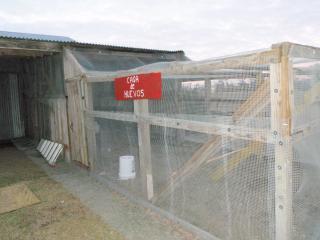- Jun 20, 2011
- 6
- 1
- 7
Recently, I built my family our first chicken coop, and we rushed out and got 6 of the cutest little baby chicks!
Here's a picture of the coop:

However, the area that I live in is chock full of raccoons...as in I could walk out into my yard at any hour of the night and see at least 4 of them sitting on my deck or finding a new way to break into my trash cans.
What I was wondering is which method would be most effective (cost is not a problem), for keeping raccoons out of my chicks! I put them up into their coop at night (learned the hard way that they can't sleep in the run
 , ), and I ran two layers of chicken wire around the entire run, but I know this will eventually be breached by the coons. Today, I am finishing the transformation of "Coop" to "Fort Knox", and I was curious as to what would be the best method of keeping out predators, but particularly raccoons. It seems that a lot of people prefer the electric fencing, and since my coop is rather small, it would be easier to do, but what about digging? Will a racoon dig underneath the electric fencing and break into my run? If I bury hardware cloth 8 inches deep around my run, surely they can't dig through that, but being raccoons, they'd probably end up finding a way in.
, ), and I ran two layers of chicken wire around the entire run, but I know this will eventually be breached by the coons. Today, I am finishing the transformation of "Coop" to "Fort Knox", and I was curious as to what would be the best method of keeping out predators, but particularly raccoons. It seems that a lot of people prefer the electric fencing, and since my coop is rather small, it would be easier to do, but what about digging? Will a racoon dig underneath the electric fencing and break into my run? If I bury hardware cloth 8 inches deep around my run, surely they can't dig through that, but being raccoons, they'd probably end up finding a way in.
I may, in the long run, end up doing both, but for now, which method should let me, and my chicks, sleep a little more soundly at night?
Thank youu

Here's a picture of the coop:

However, the area that I live in is chock full of raccoons...as in I could walk out into my yard at any hour of the night and see at least 4 of them sitting on my deck or finding a new way to break into my trash cans.
What I was wondering is which method would be most effective (cost is not a problem), for keeping raccoons out of my chicks! I put them up into their coop at night (learned the hard way that they can't sleep in the run

I may, in the long run, end up doing both, but for now, which method should let me, and my chicks, sleep a little more soundly at night?
Thank youu





